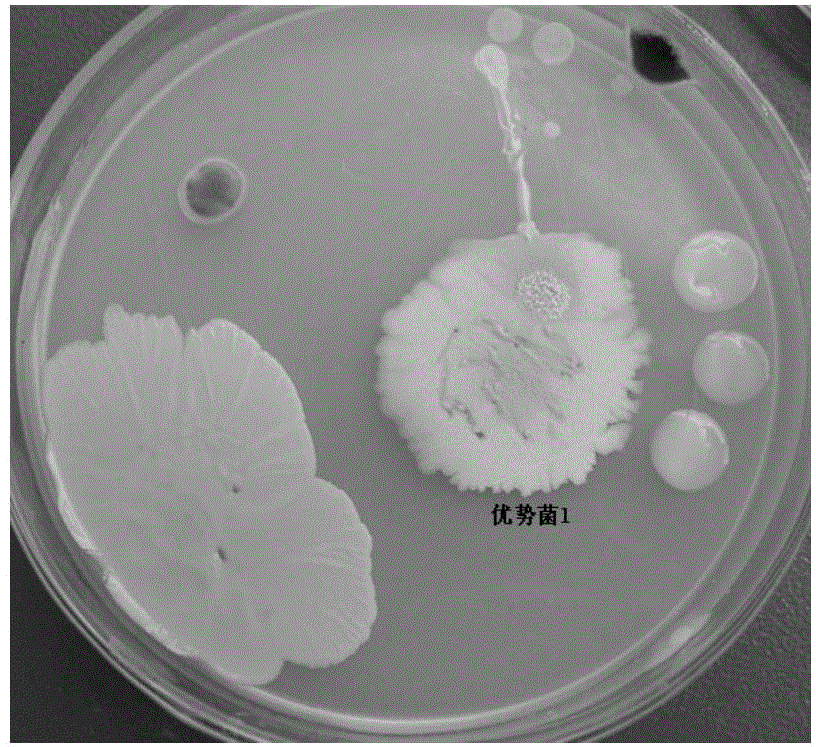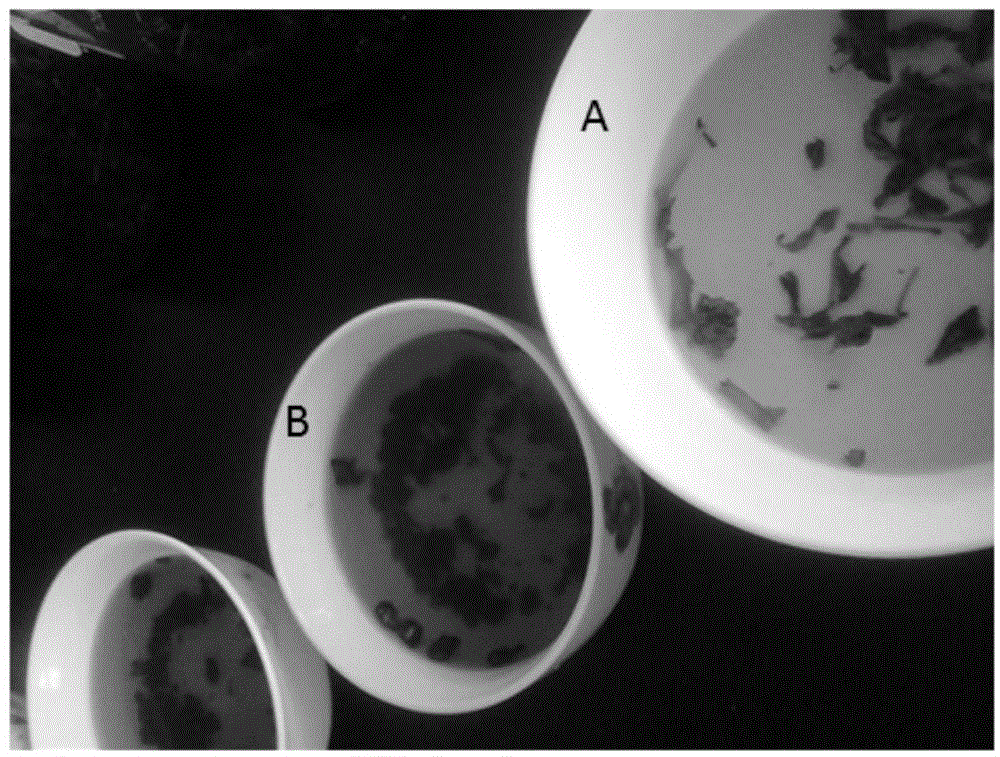A strain of Bacillus pumilus and its application
A technology of Bacillus pumilus and bacillus, which is applied in the field of fermented tea, can solve the problems of poor retention and poor brown color formation, and achieve the effect of good brown color formation and high content
- Summary
- Abstract
- Description
- Claims
- Application Information
AI Technical Summary
Problems solved by technology
Method used
Image
Examples
Embodiment 1
[0037] Example 1: Isolation and screening of strains
[0038] 1) Processing of raw materials (naturally fermented tea)
[0039] Weigh 5g of Duosuike natural fermented tea obtained by the conventional method of our laboratory fermentation into a sterile Erlenmeyer flask, add 50mL sterile water, shake for 30min, get 10 -1 Diluent; then use a 1mL pipette to draw 10 -1 1mL of the diluent, transfer it into a test tube containing 9mL of sterile water, shake to mix the bacteria evenly, and it is 10 -2 Diluent; and so on, serially dilute to make 10 -3 , 10 -4 , 10 -5 Wait for a series of diluted bacteria solution.
[0040] 2) Separation and cultivation of dominant microorganisms in naturally fermented tea
[0041] Number the medium plate, and then pipette 10 -3 , 10 -4 , 10 -5 Inoculate 0.2 mL of each diluted bacterial solution on potato dextrose agar (PDA) medium (potato 20%, glucose 2%, agar 2%, natural pH) with different dilution numbers, and then use a sterile coating stick to inoculate th...
Embodiment 2
[0080] Example 2: Identification of strains
[0081] 1) Colony characteristics:
[0082] Streak the dominant bacteria 1 on sugar agar (PDA) medium (potato 20%, glucose 2%, agar 2%, natural pH), then turn the plate upside down and incubate at 28°C for 2 days, observe and record the growth of colonies on the plate . figure 1 The colony characteristics of the dominant bacteria 1 are generally as follows: round colony, milky white, dry surface, dull, jagged edges, irregular, large colony diameter, raised in the middle, and wrinkled.
[0083] 2) Gram stain: rod-shaped, stubby, blue-purple.
[0084] 3) Physiological and biochemical identification
[0085] (1) Ampicillin sodium medium: add ampicillin sodium at a final concentration of 100 mg / mL to PDA plate medium (potato 20%, glucose 2%, agar 2%, natural pH), and inoculate the dominant bacteria at 1,28°C Cultivate for 2 days, observe the growth of dominant bacteria 1 on the PDA plate medium supplemented with ampicillin sodium, and identify ...
Embodiment 3
[0098] Example 3: Brewing effect of Bacillus pumilus 13-03 pure-bred fermented multi-suike fermented tea
[0099] Take 5g of the fermented multi-suike tea and 5g of the original tea (before fermentation) obtained by pure-bred fermentation of Bacillus pumilus 13-03 according to the method of Example 1 in 3) and brew them in boiling water for 15 minutes, and compare their tea color and taste .
[0100] figure 2 Shows the results of comparing the brown color of the fermented Dosikee fermented tea produced by the fermentation of Bacillus pumilus 13-03 of the present invention and the original tea (before fermentation) after brewing. The tea color is brown (B), which is obviously different from the light green (A) of the original tea. The prepared Tohoke fermented tea has a soft and mellow taste, and has the sweetness of Tohoke itself.
PUM
 Login to View More
Login to View More Abstract
Description
Claims
Application Information
 Login to View More
Login to View More - R&D
- Intellectual Property
- Life Sciences
- Materials
- Tech Scout
- Unparalleled Data Quality
- Higher Quality Content
- 60% Fewer Hallucinations
Browse by: Latest US Patents, China's latest patents, Technical Efficacy Thesaurus, Application Domain, Technology Topic, Popular Technical Reports.
© 2025 PatSnap. All rights reserved.Legal|Privacy policy|Modern Slavery Act Transparency Statement|Sitemap|About US| Contact US: help@patsnap.com



